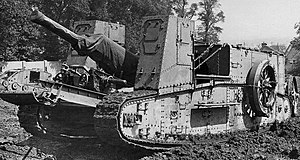Gun Carrier Mark I
| Gun Carrier Mark I | |
|---|---|

British Gun Carrier Mark I fitted with a 60-pounder gun
|
|
| Type | Self-propelled artillery |
| Place of origin |
|
| Service history | |
| Used by | UK |
| Wars | World War I |
| Production history | |
| Designed | July 1916 |
| Manufacturer | Kitson & Co. |
| Produced | June–July, 1917 |
| No. built | 48 |
| Variants | Gun Carrier Crane, Gun Carrier Mark II (project only) |
| Specifications | |
| Weight | 27 long tons (27 t) unloaded, 34 long tons (35 t) maximum |
| Length | 30 ft (9.1 m), 43 ft (13 m) with tail |
| Width | 11.6 ft (3.5 m) |
| Height | 7.9 ft (2.41 m) |
| Crew | 6 + gun crew |
|
|
|
|
Main
armament |
60-pounder gun or 6-inch 26 cwt howitzer |
| Engine | Daimler petrol engine 105 hp |
| Suspension | Unsprung |
|
Operational
range |
23.5 mi (37.8 km) |
| Speed | 3.70 mph (5.95 km/h) |
The Gun Carrier Mark I was the first piece of self-propelled artillery ever to be produced, a British development from the First World War.
During 1916 it became clear that in case of a breakthrough, the very purpose of the first tank, the Mark I, artillery would have great trouble following the advancing troops. Any successful offensive would therefore be in danger of stalling immediately. To solve this problem, Major John Greg, an engineer working for the main tank producing company Metropolitan, Carriage, Wagon and Finance, proposed to build special mechanised artillery, using parts of the Mark I. The production of a prototype was approved on 5 June 1916; the actual design began in July. The first prototype was ready to participate in the Tank Trials Day at Oldbury on 3 March 1917. An order of fifty vehicles was given to Kitson & Co. in Leeds. Deliveries to the army started in June and ended in July of the same year.
The vehicle bore little resemblance to the Mark I. The tracks retained a vestige of the 'lozenge' form but very low, almost flat. At the rear a rectangular superstructure covered the Daimler 105 hp engine and transmission of the Mark I; the transmission was reversed compared to its position in the Mark I. This structure also housed the vehicle commander, a mechanic and two gearsmen. The original double tail wheel of the Mark I (intended to aid steering but often omitted in action) was attached to the rear of the vehicle and seems to be retained in photographs.
The front section, an open area between the tracks, was flanked by tall narrow structures, above the front of the track frame at each side, that acted as armoured cabs for driver on the left and brakesman to the right. In the prototype these driving positions had been directly in front of the superstructure; moving them forward greatly improved visibility, but made communication very difficult. This arrangement had obvious disadvantages where, as in the Mark I, four men, including the gearsmen, had to coordinate their actions to drive and manoeuvre a most ungainly vehicle. Between these two structures lay a low-slung pivoting platform able to accommodate a 60-pounder (5-inch) gun, a 6-inch 26 cwt howitzer or any equivalent in stores or personnel.
...
Wikipedia
